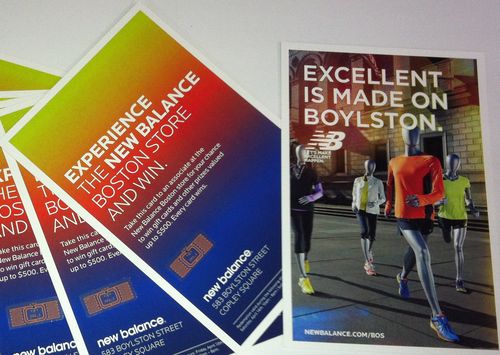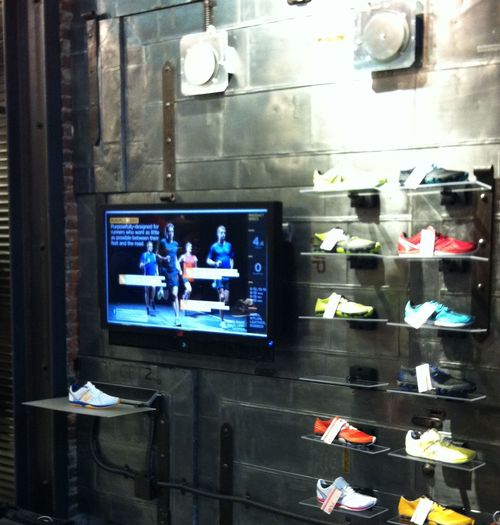The New Balance Experience Store in Boston opened its doors earlier this month, boasting an automated system to attract customers to their products by means of an RFID-enabled video display and hotspot, and RFID-enabled prize cards distributed on the streets.
The system features RFID software by InMotion Retail Marketing, the RFID division of Pittsfield ID Technologies, and multimedia content provided by advertising agency Almighty. The solution not only uses the wireless technology to trigger content for shoppers, it also collects data about the popularity of the displayed shoes based on how many times each one is moved.
The Boston store is located on Boylston Street near the finish line of the 2012 Boston Marathon, which was held on Monday, Apr. 16, and therefore experienced heavy traffic from shoppers during its grand opening. As part of the promotion to attract customers, says David Chaput, New Balance’s business solutions manager, the company handed out approximately 6,000 prize cards the day of the race. “We wanted to measure street distribution of marketing material during our grand opening” he says. “We had a significantly positive response.”
Pittsfield ID had already been providing brand labels for New Balance products in its stores nationwide, explains Karen Bleckmann, Pittsfield’s managing director. With the use of RFID, labels could be used to not only provide digital content for shoppers while in the store, but to collect data about how many time products were handled by potential buyers.
InMotion installed a 9-foot-wide, floor-to-ceiling wall display, with shelving on which a dozen shoes are placed. Each shoe is a different model and adhered to its insole is a UPM RFID (now part of Smartrac) Belt EPC Gen 2 passive UHF RFID tag with an Impinj Monza 5 chip. The ID number encoded to the tag is linked to the product’s SKU and other descriptive data stored in a cloud-based server hosted and managed by Freedom Shopping.
The wall display comes with a single Impinj Speedway Revolution reader and four antennas. Two circular polarized antennas are installed above the display to detect when a shoe has been moved, indicating that it most likely has been picked up by a shopper. (A similar inMotion system is in use by LL Bean to provide shopper content and track the interest in athletic boots displayed in some of the company’s stores (see LL Bean Tries to Hike Sales with RFID.)
The wall display includes an RFID “hotspot,” where linear and near-field reader antennas are installed, as well as a 42-inch touch screen. The linear antenna reads a shoe’s RFID tags when brought within range, and can then trigger the displaying of content about that shoe model, while the near-field antenna captures the ID number of RFID tags built into reward cards.
If a shopper picks up a shoe of interest on the display, the system updates the server regarding the action that has taken place. The software collects each read event indicating movements of the products throughout the day and enables the store to then compare that data with actual purchases at the point of sale. It also triggers a large image of the shoe to be displayed on a 42-inch touch screen next to the display. Text on the screen instructs the shopper to place the shoe on the RFID hotspot—counter beneath the screen—to learn more about that model. When the shoe is placed on hotspot’s counter, the linear antenna captures its tag ID number, which is sent to Almighty’s server, which displays details about the shoe’s features on the screen.
The system is intended not only to interest customers and boost sales, it also provides marketing analytics by tracking how a shoe is handled. Pittsfield ID’s InMotion software analyzes changes in a tag’s RF signals and based on those changes, the software can then determine if a customer has picked up the item to which that tag was attached. Just how InMotion accomplishes this, says Frederick Bleckmann, the company’s VP of development, is proprietary
The InMotion software records movement data indicating the number of times that each product is picked up, and for how long. That information can then be compared against the point-of-sale records for the same day. In this way, New Balance can analyze the level of interest that each product generates, whether that interest leads to sales and whether the media content seems to be increasing the number of purchases.

For the promotion, store staff also distributed 6,000 rewards cards with built-in UPM Trap EPC Gen 2 RFID tags, each with an Impinj Monza 4 chip encoded with a unique ID number that is linked in the software to a specific prize—anything from a pair of socks to $500 cash. The card recipients were invited to come into the store to learn exactly which prizes they won and to redeem the rewards. When a shopper places a card on the counter within six inches of the near-field antenna, its tag ID is read and the prize was announced on the screen. The winner then could do her shopping, if she so chooses, then redeem the prize at the point of sale while making a store purchase. Staff use an Alien Technology ALH-9000 handheld to read the reward cards at the point of sale, and that data is sent to the back-end server via a Wi-Fi connection.
InMotion software records the time at which the card is first read at the hotspot, as well as the moment it is redeemed at point of sale, providing data as to how long the shopper typically spent in the store before redeeming the prize.
“We were looking for a new and innovative way to engage our customers,” Chaput says, He adds that thus far, the customers have been “very positive and excited” about the system. In the future, he says, the company wants to use the technology in other New Balance stores.



